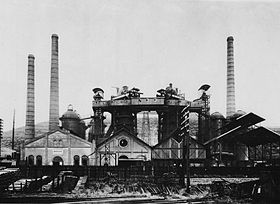Bremer Hut (Geisweid)

The Bremer Hütte was a steel works in today's Siegen district of Geisweid in the Siegerland . The resulting AG Bremer Hütte was at times the second largest company in Siegerland.
history
In 1873 the Bremer Hütte was built and put into operation by merchants from Bremen . In the years that followed, however, their company ran into financial difficulties. In 1880 the hut was therefore transferred to the Bremer Bank, which leased it to the church councilor Walter Siebel, director of the Storch & Schöneberg mine . In 1888 the Bremer Hütte company was founded. At the turn of the century, Friedrich Flick , later director of the Charlottenhütte in Niederschelderhütte , completed his business apprenticeship in the Bremer Hütte. In 1917 the Bremer Hütte was merged with the Gosenbacher union Storch & Schöneberg, which had also owned the Gosenbacher Hütte since 1895 , to form Storch & Schöneberg AG for mining and ironworks.
The company acquired several industrial companies in Klafeld, Geisweid, Haardt , Weidenau and Netphen , including rolling mills . The company incorporated boiler, rivet and apparatus production and brickworks and became the second largest company in Siegerland after the aforementioned Charlottenhütte with a total of 2,700 employees. In the 1920s, the Mannesmann Group took a stake in Bremer Hütte and acquired a third of all shares. From then on, steel and pig iron from the smelter mostly went to Mannesmann. After Mannesmann had built a large blast furnace plant on the Lower Rhine and took over the majority of shares in the Siegerland company, the smelter was shut down on January 31, 1930 and dismantled or demolished by 1934. Geisweider Eisenwerke took over the site and in 1936/1937 some buildings. Today the Monte Schlacko still reminds of the former operation of the Bremer Hütte.
Metallurgical plant and works railways
The hut was partly on Geisweider and partly on Weidenau area. While the two blast furnaces of the ironworks were in Weidenau, the rest of the plant was in the Geisweider district. The two blast furnaces each had a capacity of 150 t.
The works railways of the hut had a gauge of 750 mm and standard gauge. While the standard gauge led to the Geisweider train station, the narrow-gauge railways were only used to supply the blast furnaces with ore and coke and to remove the slag .
Individual evidence
- ^ Mention of W. Siebel in the book "Kirchen und seine Dörfer" , accessed on July 21, 2012
- ↑ a b c d e f g h i Andreas Christopher, Gerhard Moll, Achim Schönberger: Privat- und Werksbahnen im Siegerland , Verlag Kenning, 1995, ISBN 3-927587-27-3 , page 94.
- ↑ Information on Geisweider Eisenwerke AG
literature
- Siegerländer Heimat- und Geschichtsverein eV (Ed.) In the land of ore mines, ironworks and Hauberge - On the way with the photographer Peter Weller , Vorländer Verlag, Siegen 2011. ISBN 978-3-923483-73-0 .
Coordinates: 50 ° 54 ′ 35.4 " N , 8 ° 0 ′ 56.7" E